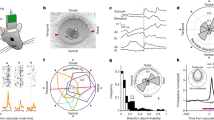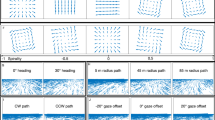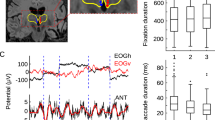Abstract
FOLLOWING inspection of a rotating spiral, there is an illusion of counter-rotation when the spiral is stationary. This motion after-effect was studied as early as 1849 by Plateau1, and is believed to be caused by the fatiguing or reduction in the maintained discharge of one set of directionally sensitive units in the visual system2–5. Locating the part of the human brain where these adapted “movement detectors” reside, however, has been difficult. Two facts suggest that the major component of the motion after-effect is not in the retina: first, the after-effect transfers from one eye to another6,7; and second, inter-ocular transfer persists even when the previously adapted eye is pressure-blinded8,9. This evidence has led most workers to conclude that the motion after-effect is a cortical phenomenon. But, considering the wealth of recent electro-physiological data revealing directionally sensitive units in the optic tectum (superior colliculus) of many different mammals10–14, the midbrain appears to be an equally plausible site.
This is a preview of subscription content, access via your institution
Access options
Subscribe to this journal
Receive 51 print issues and online access
$199.00 per year
only $3.90 per issue
Buy this article
- Purchase on Springer Link
- Instant access to full article PDF
Prices may be subject to local taxes which are calculated during checkout
Similar content being viewed by others
References
Plateau, J., Bull. Acad. Roy. Sci. B. A. Belg., 16, 254 (1849).
Exner, S., Biologisches Centralblatt, 8, 14 (1888); Zeitschr. F. Psychologie und Physiologie der Sinnesorgane, 21, 388 (1899).
Sutherland, N. S., Quart. J. Exp. Psychol., 13, 222 (1961).
Sekular, R. W., and Ganz, L., Science, 139, 419 (1963).
Barlow, H. B., and Hill, R. M., Nature, 200, 1345 (1963).
Wohlegemuth, A., Brit. J. Psychol., Mono. Suppl. 1 (1911).
Freud, S. L., Amer. J. Psychol., 77, 422 (1964).
Barlow, H. B., and Brindley, G. S., Nature, 200, 1347 (1963).
Scott, T. R., and Wood, D. Z., Amer. J. Psychol., 79, 435 (1966).
Horn, G., and Hill, R. M., Exp. Neurol., 14, 199 (1966).
McIlwain, J. R., and Buser, P., J. Physiologie, 59, 263 (1967).
Humphrey, N. K., Exp. Neurol., 20, 312 (1968).
Wickelgren, B., and Sterling, P., Physiologist, 10, 344 (1967).
Sprague, J. M., Marchiafava, P. L., and Rizzolatti, G., Arch. Ital. Biol., 106, 169 (1968).
Richards, W., Kybernetik, 4, 146 (1968).
Teuber, H.-L., Battersby, W. S., and Bender, M. B., Visual Field Defects after Penetrating Missile Wounds of the Brain, 31 (Harvard University Press, Cambridge, 1960).
Author information
Authors and Affiliations
Rights and permissions
About this article
Cite this article
RICHARDS, W., SMITH, R. Midbrain as a Site for the Motion After-effect. Nature 223, 533–534 (1969). https://doi.org/10.1038/223533a0
Received:
Revised:
Issue Date:
DOI: https://doi.org/10.1038/223533a0
This article is cited by
-
Effects of chlorpromazine and promazine on the visual aftereffects of tilt and movement
Psychopharmacology (1983)
-
A neurophysiological model for anomalous correspondence based on mechanisms of sensory fusion
Documenta Ophthalmologica (1981)
-
Association and dissociation of visual functions in a case of bilateral occipital lobe infarction
Archiv f�r Psychiatrie und Nervenkrankheiten (1978)
Comments
By submitting a comment you agree to abide by our Terms and Community Guidelines. If you find something abusive or that does not comply with our terms or guidelines please flag it as inappropriate.



